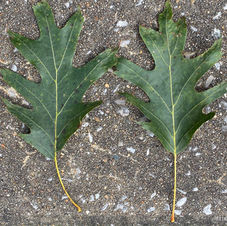Northern Red Oak
Quercus rubra
Description:
The northern red oak is the namesake oak species of the red oak group. Often simply called red oak, it can grow very large and is found across the eastern US. Acorns are a valuable food source for wildlife.
Habitat:
Uplands and bottomlands, but usually not in very wet or dry locations.
Gallery
Look-alike oaks:
Southern Red Oak - leaves of the northern red oak have shallower sinuses, and lack the rusty underside of southern red oak leaves. Acorns of the southern red oak are much smaller. Mature bark of southern red oak does not have the pale gray ridges or "ski tracks" of northern red oak.
Scarlet Oak - Bark is very similar, often identical. However, the bark of scarlet oak is often rougher or more blocky near the base of the tree. Acorns of scarlet oak have larger caps covering up to 1/2 of the acorn, while caps of northern red oak acorns only cover about 1/4 of the nut. Leaves of scarlet oak have deep sinuses, often nearly reaching the midvein, while those of northern red oak are shallower, only reaching about half way to the midvein.
Black Oak - bark of mature black oak trees is rougher and usually more solid dark gray to black, and lacks the pale gray "ski tracks" of northern red oak. Leaves of both species have long petioles and "drooping" leaves; however, leaves of black oak have some amount of pubescence on the undersides, while northern red oak leaves are smooth underneath. Northern red oak leaves are a darker green than those of black oak.
Shumard Oak - Acorns can be similar between the two species. However, leaves of shumard oak have deep sinuses, and undersides of leaves have tufts of brown hairs between the midvein and side veins, unlike those of northern red oak. Bark of shumard oak is also typically smoother and more uniform gray in color.



















